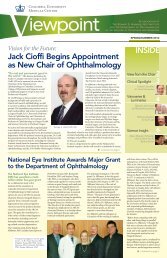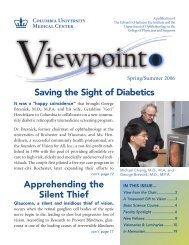Faculty Spotlight - Department of Ophthalmology, Columbia University
Faculty Spotlight - Department of Ophthalmology, Columbia University
Faculty Spotlight - Department of Ophthalmology, Columbia University
You also want an ePaper? Increase the reach of your titles
YUMPU automatically turns print PDFs into web optimized ePapers that Google loves.
Expert Care for Growing Eyes<br />
continued from page 7<br />
medical care and diagnosis <strong>of</strong> the<br />
eye conditions that affect children.”<br />
Pediatric and adult strabismus specialist<br />
Howard Eggers,<br />
M.D. is the primary teacher <strong>of</strong><br />
strabismus surgery techniques, a<br />
very important part <strong>of</strong> resident<br />
training. “He’s the best in the city,”<br />
notes Dr. Flynn.<br />
“With congenital misalignments,<br />
it’s important to get the eyes<br />
straight as early as possible,” Dr.<br />
Eggers cautions.<br />
“Pediatricians<br />
normally send<br />
us babies at six<br />
months, but<br />
even earlier is<br />
better. The<br />
quality <strong>of</strong> the<br />
child’s binocular<br />
sensory<br />
Howard Eggers, M.D. experience is at<br />
stake.” New<br />
research recommends straightening<br />
the eyes by four months, the age at<br />
which the brain develops depth<br />
perception. Motor alignment (both<br />
eyes moving together) is required<br />
for the brain’s sensory system to<br />
Charles Manley<br />
V ıewpoınt<br />
THE EDWARD S. HARKNESS EYE INSTITUTE AND<br />
THE DEPARTMENT OF OPHTHALMOLOGY<br />
635 WEST 165TH STREET<br />
NEW YORK, NY 10032-3797<br />
develop properly. Untreated, strabismus<br />
can result in amblyopia<br />
(“lazy” eye) in which the child uses<br />
one eye more than the other. This<br />
condition can result in permanent<br />
vision loss because the brain suppresses<br />
the portion <strong>of</strong> vision that<br />
is ignored.<br />
Dr. Eggers <strong>of</strong>ten uses corrective surgical<br />
alignment for children.<br />
However with teenagers and adults,<br />
he may employ adjustable sutures<br />
for more precise alignment and<br />
Botox for minimally invasive<br />
“micro” alignment. “Most people<br />
don’t know that Botox was invented<br />
for aligning eyes,” he explains.<br />
Dr. Eggers was in the first investigator<br />
group <strong>of</strong> the FDA study that<br />
approved the use <strong>of</strong> Botox for strabismus.<br />
“On teenagers and adults,<br />
Botox is easily tolerated and can<br />
rein in small deviations by relaxing<br />
the one muscle that is pulling harder<br />
than the opponent muscle.”<br />
Dr. Chiang, who also treats patients<br />
with strabismus, feels one should<br />
not underestimate the emotional<br />
consequences <strong>of</strong> eye misalignment.<br />
“This is not simply a ‘cosmetic’<br />
Charles Manley<br />
Robert Lopez, M.D. with two-year old Faith Bravo and her parents,<br />
Maria and Peter Bravo.<br />
surgery. Direct eye contact is a crucial<br />
part <strong>of</strong> interpersonal communication.<br />
There is a growing body<br />
<strong>of</strong> literature exploring the negative<br />
impact <strong>of</strong> misaligned eyes on how<br />
one’s intelligence and honesty are<br />
perceived by others. Realignment <strong>of</strong><br />
the eyes can make a tremendous<br />
difference in self-confidence and<br />
self-esteem.”<br />
Many other attending physicians<br />
staff the specialty clinics and train<br />
residents in the diagnosis and treatment<br />
<strong>of</strong> both children and adults.<br />
Michael Kazim, M.D. specializes<br />
in diseases <strong>of</strong> the orbit.<br />
Lama Al-Aswad, M.D. treats<br />
pediatric and juvenile glaucoma.<br />
She emphasizes early screening.<br />
“Pediatric glaucoma is uncommon<br />
and juvenile glaucoma is very rare,<br />
but in both cases, the risk <strong>of</strong> blind-<br />
Important Patient Care Telephone Numbers<br />
Cornea/External Ocular Disease: 212.326.3320<br />
Glaucoma: 212.342.0943<br />
Pediatric <strong>Ophthalmology</strong> and Strabismus: 646.422.0200<br />
Refractive Surgery/LASIK: 212.326.3320<br />
Vitreoretinal and Uveitis: 646.422.0200<br />
ness is much greater because we<br />
have to manage the disease from<br />
childhood on through adulthood,”<br />
she says. “Sadly, many children go<br />
undiagnosed for too long. Early<br />
diagnosis and expedited treatment<br />
can make a tremendous difference<br />
in helping these children retain<br />
their sight.”<br />
Dr. Flynn commends all who collaborate<br />
in the excellent care <strong>of</strong><br />
children and their families at the<br />
Eye Institute and the Children’s<br />
Hospital. “The gift <strong>of</strong> vision is precious.<br />
It is our responsibility to care<br />
for all who come through our<br />
doors with knowledge, compassion<br />
and skill,” he says. “Every day, our<br />
physicians, residents and research<br />
staff are making a difference in the<br />
lives <strong>of</strong> these children. There is<br />
nothing more gratifying.”<br />
PRESORTED<br />
FIRST CLASS MAIL<br />
U.S. POSTAGE<br />
PAID<br />
WATERBURY, CT<br />
PERMIT NO. 186





